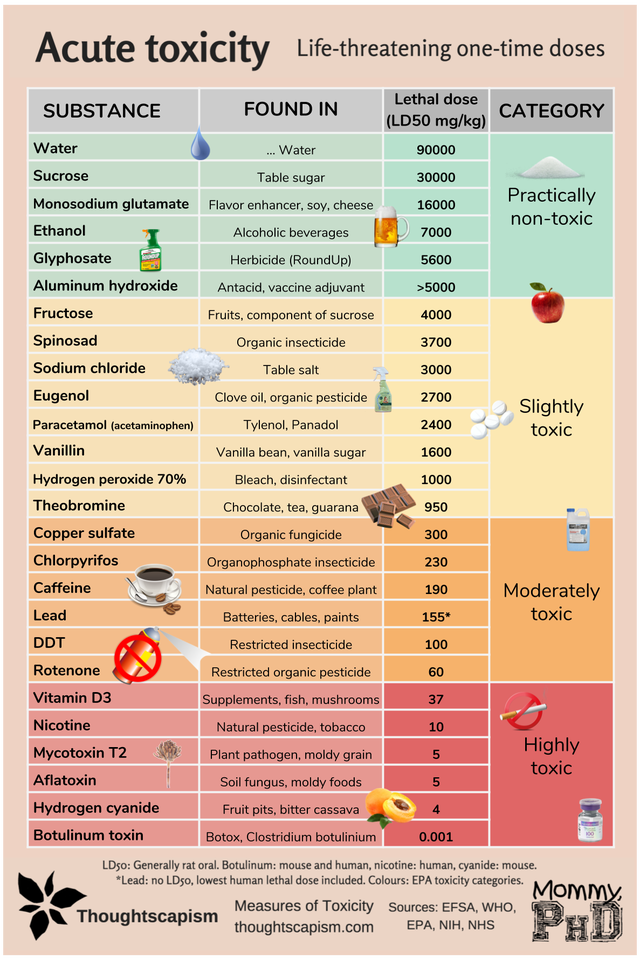Do you need to detox?
The green photo, above, is from a handout on detoxing. It claims “we are all toxic.” The language in the handout is horrifying. It demonizes a variety of foods, including (no surprise) sugar. It throws around the big zingers: chemical and toxic. An avalanche of food morality and fear-mongering runs rapid in the detox booklet.
It’s as if the person writing it has no background in science…or at the very least is ignoring it. A clever selling tactic for their $80 detoxifying powders and equally expensive supplements. All for your chemical-laden body.
Except…EVERYTHING IS MADE UP OF CHEMICALS. You are a walking, talking, breathing chemical machine. Four chemical elements: oxygen, hydrogen, carbon, and nitrogen, make up 96% of your body.
It is IMPOSSIBLE to embrace “chemical-free” living.
And just because you can’t pronounce it (thank you, Michael Pollen and Food Babe, for that gem) it doesn’t mean it is “bad” for you.
Ethanoate, 2-Methylbutul Ethanoate, tryptophan, and linoleic acid are all difficult to say ingredients in a banana. A perfectly delicious, nutritious snack.
I know what some of you are thinking, BUT some chemical are toxic. I hear you. However, “toxic chemicals” isn’t the term you are looking for, rather “toxic dose.” You’ve all likely seen the saying, “the dose makes the poison.” This is true for all chemicals, including natural and organic ones.
Ep.6/
Loving Yourself
Any compound can be toxic if you eat, drink or absorb too much of it. This also means foods/ingredients referred to as “toxic” may in fact be harmless at the dose we consume in a typical diet.
For example, vitamin D can lead to kidney failure, deafness and even death, when the dose is too high.
Yet a complete elimination of vitamin D is not the answer for optimal health.
This is an important concept to understand to prevent unnecessary food worry and food elimination: just because a chemical is present, does not mean the dose is harmful.
Now, let’s talk about sugar. IT IS NOT TOXIC. SUGAR IS NOT TOXIC.
A toxin (a noun) refers to toxic chemicals created by plants and animals, usually for their own defense
Sugar is one of the least-toxic of the chemicals we consume. Toxicity of substances is classified by measuring what happens when a single dose of the compound is fed to rats.
The lethal dose per kilogram of body weight can then be established, i.e. what dose it takes to kill half (50 percent) of the rats. This “lethal dose” is known as LD50 and is expressed in terms of the dose per kilogram. The lower the LD50, the greater the toxicity (meaning it took less of the substance to kill a rat) and conversely, a higher LD50 means the lower the toxicity (more of the compound was consume without killing rats). Based on rat studies, the following is true (handout linked for reference):
Nicotine and vitamin D (calciferol) LD50: 10 mg/kg and 37 mg/kg (highly toxic)
Caffeine — LD50: 190 mg/kg (moderately toxic)
Table salt — LD50: 3000 mg/kg (slightly toxic)
Table Sugar — LD50: 30,000 mg/kg (practically nontoxic)
If I did my math correctly, this would come out to 135 full size Snicker bars for a 200 lb human.
So…the next time someone claims a food or chemical is “toxic,” ask at what dose or concentration. If they can’t answer that, they are likely ignoring science and/or attempting to sell you something.



